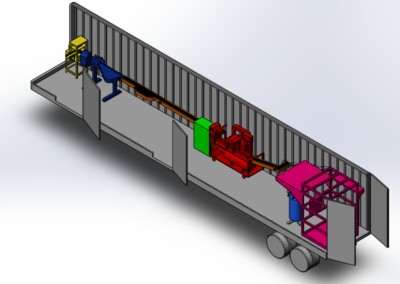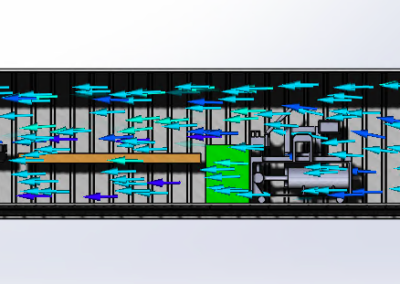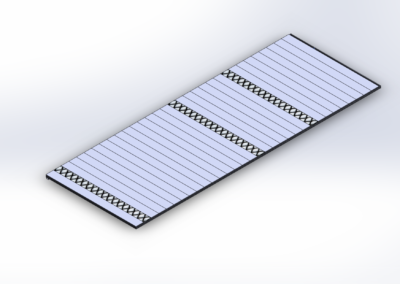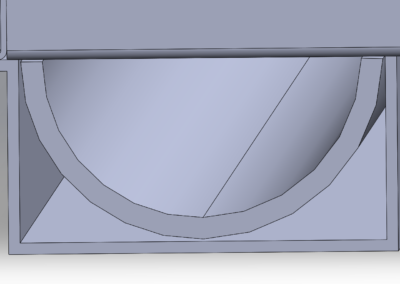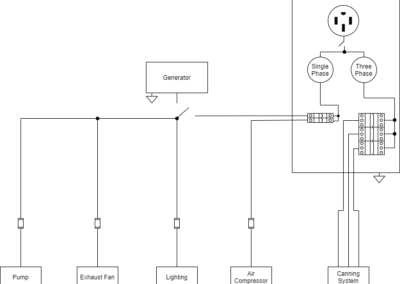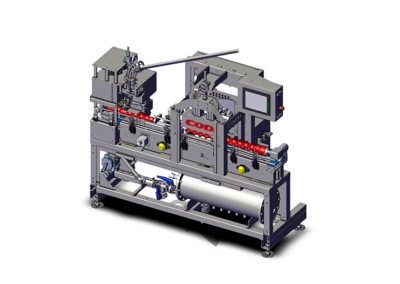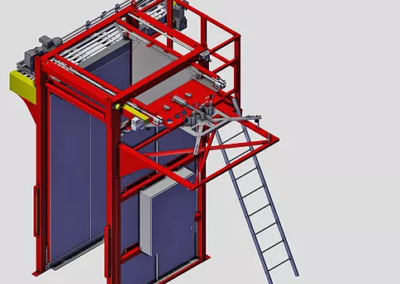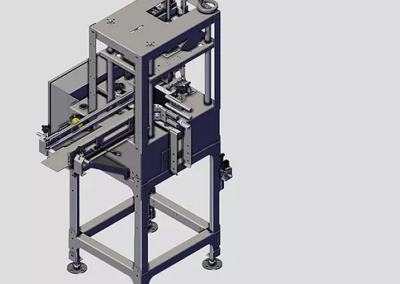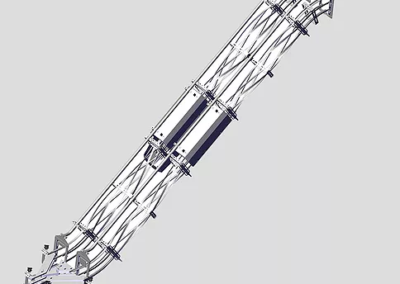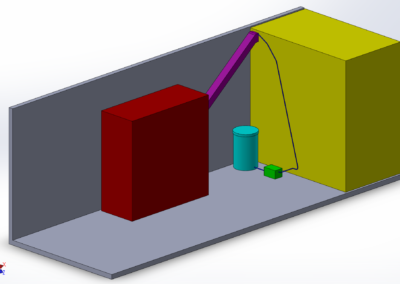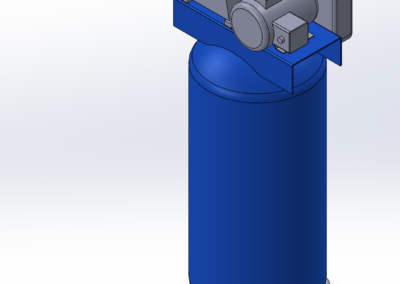Mobile Microbrewery Bottling Trailer – F20.49.1
Overview
Our team was tasked with creating a mobile microbrewery canning trailer for breweries in the greater Denver area. Canning is a costly process, especially for microbreweries that operate with limited space and funds. Current mobile solutions for this issue involve wheeling large machines into the microbrewery to perform the canning process. This approach halts microbrewery operations and wastes valuable time and energy better spent on the production of beer. The project has aimed to minimize client involvement in the canning process while maintaining a high standard product.

Live Zoom Chat
Use the link below to join us live from 8:00 – 10:30 a.m. on December 3.
Please use passcode: 989198
Join from PC, Mac, Linux, iOS or Android: https://mines.zoom.us/j/99628107286?pwd=T0YwVmlkTkhGc3owbkU2SUh4aXFNUT09
Password: 989198
Or iPhone one-tap: 16699006833,99628107286# or 12532158782,99628107286#
Or Telephone:
Dial: +1 669 900 6833 (US Toll) or +1 253 215 8782 (US Toll)
Meeting ID: 996 2810 7286
International numbers available: https://mines.zoom.us/u/a8yKWL9Oi
Team Members
- Colin O’Connell
- Colter Wagner
- Jake Little
- Nadia Smith
- Nils Ericsson
- Owen Brasseaux
- Sydnee Rumbaugh
The Client
- John Persichetti
Acknowledgements
Project Advisor: Professor Michael Yost
Technical Advisor: Dr. Stephen Geer, Andrew Ferguson
Video
Elevator Pitch
The current design is unique to other mobile canning solutions. The entire line is fully operational and fully mobile within the trailer itself. This means setup time is significantly reduced and the process is not intrusive to the microbrewery’s daily operation. Our canning line has been designed to utilize CODI’s customizable products to ensure compatibility between each subsystem. This design also guarantees a moderate output of 6,000 cans per day easily matching the output of well-established breweries. The economic potential of this venture cannot be stated with words alone but can be easily shown through our projected return on investments detailed later on the project.
Trailer 3-D Model
A 3D model was created in an effort to showcase the flow of a canning line as well as the ability to house the entire system within a confined space.
Ventilation
To promote proper ventilation, a fan was chosen to efficiently move air while also being non disruptive to the canning process. A computational fluid dynamics study was performed in order to verify total air replacements per hour.
Drainage
To minimize cross contamination and safety risks due to water hazards, a drainage system similar to a traditional roof gutter was integrated into the frame rails of the trailer.
Drainage – Close up
The drainage system funnels water towards one side of the trailer so that it can be stored in an HDPE grey water tank that can be emptied at acceptable waste water disposal locations.
Electrical Layout
This simplified model of the electrical circuit of the trailer shows the design and hook-up to the brewery’s power as well as an onboard generator. The system is designed in accordance with the National Electrical Code Book Article 545 and 552.
CCL-45 Filler
The CCL-45 filler uses a closed-loop counter pressure filling method in order to minimize dissolved oxygen levels and spillage. To assist in the canning process, it has an HMI display to read dissolved oxygen levels throughout the canning process and the CCL-45 will automatically reject faulty cans.
Depalletizer
The depalletizer takes empty can bodies from a pallet and places them on a conveyor to be washed by the twist rinse. Excess packing material is disposed of during this process.
PakTech Packager
This packager, manufactured by CODI mfg., applies PakTech can holders to a group of 4-8 cans. These holders are more environmentally friendly than traditional plastic rings and have the added benefit of recyclability.
Twist Rinse
A twist rinse is used to clean each can prior to filling. The mechanism utilizes pressurized water to clean out any dust and debris and proceeds to invert the can, emptying the contents.
Pump Procedure
In order to supply water to the Twist Rinse, an external water pump will be used to move fluid from a 30 gallon storage tank to the top of the Twist Rinse.
Design Approach
The chosen solution to designing a microbrewery canning trailer is to take current products and systems, integrate them into a trailer that could be taken from brewery to brewery, and ensure the bottling process could be done completely inside of the trailer.
Research into current canning systems led to three companies. By taking into consideration the location of warehouses, durability of products, speed of canning systems, and quality of the canned product, CODI Manufacturing was the company chosen for the canning line within the trailer. Codi Manufacturing specializes in the development of filling operations, however, they also have an extensive catalog of canning line add-ons, such as depalletizers, rinsing stations, drying stations, etc. This, along with the fact that they manufacture all of their products on a customized basis to exactly meet their clients’ needs makes them the ideal choice as a supplier for all the canning equipment. Minimal extra work will be required to integrate the canning equipment into the trailer design and because all the supporting equipment is created by Codi Manufacturing, creating an automated process will be straightforward.
Research of trailers led to three options, differing in size and subsequently the amount of space that would be available for the canning system and the driver’s license needed to operate the vehicle. Many companies offer mobile bottling/canning services. However, many current solutions house the systems in a trailer and then roll the canning line out of the trailer into the facility for the canning process. These solutions are contradictory to the given prompt, as it is assumed that the breweries that will use this product will be small and new enough that they do not have the funding, nor space, to house a canning line themselves. Because of this, four designs were chosen for comparison, a 53-foot semi-trailer, a 43-foot semi-trailer, and two box truck designs.


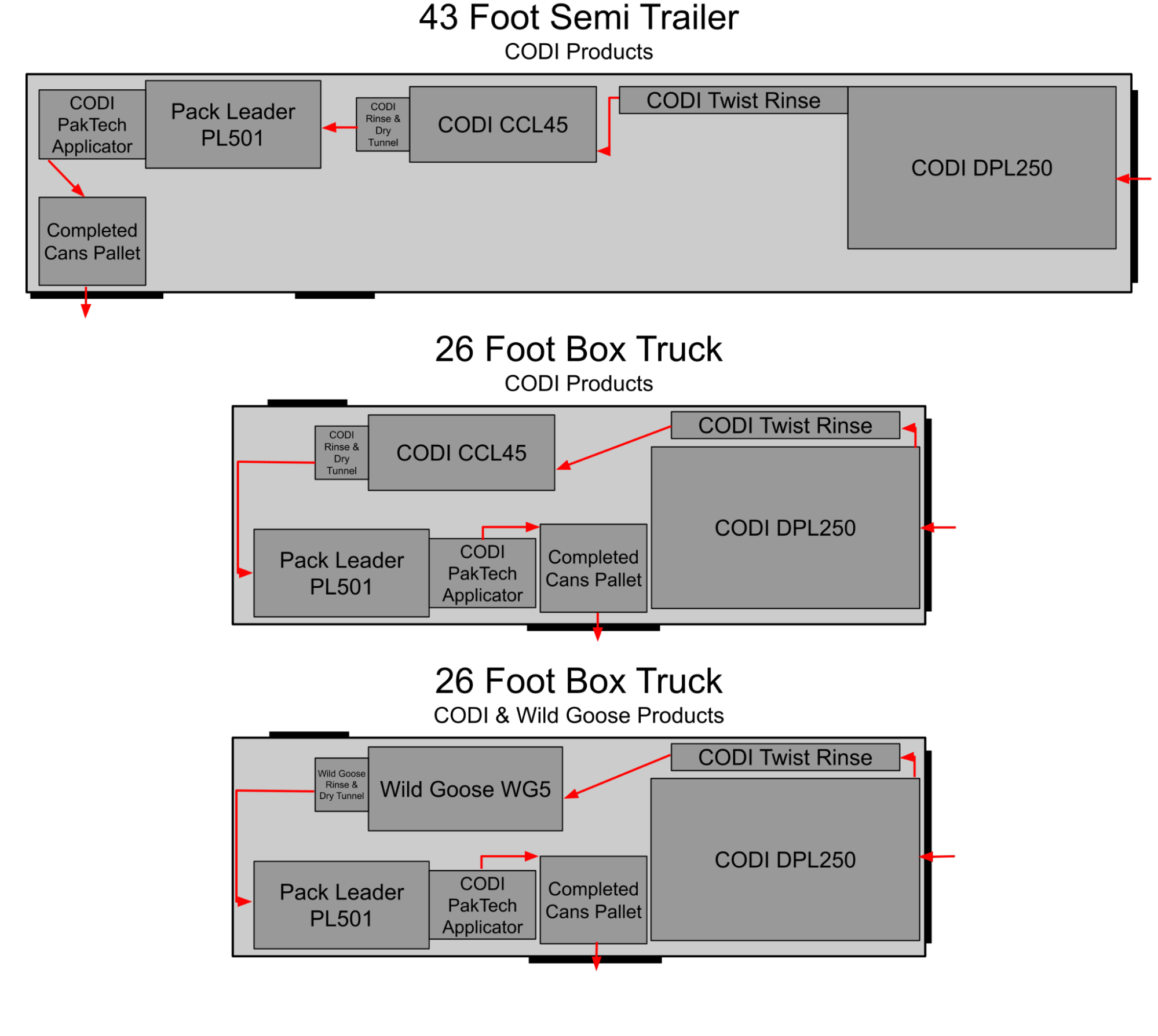
Design Solution
After iterating through multiple designs, the final product was chosen to be placed in a 53-foot semi-trailer over a 43-foot semi-trailer to maintain proper storage while still leaving enough space for employees to move around inside. Codi Manufacturing was selected to be the sole vendor of the canning line and canning accessories for their product reliability, unique solution to filling cans, and extensive catalog in supporting parts necessary for a fully operational canning line. Since a majority of the equipment utilizes pneumatic solenoids a 10 HP compressor will be used to supply a total volumetric flow rate of 35 cfm to each of the following products.
Depalletizer and Twist Rinse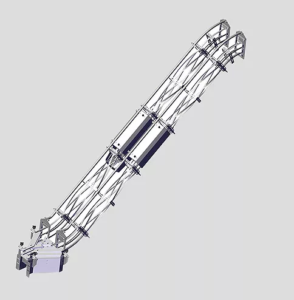
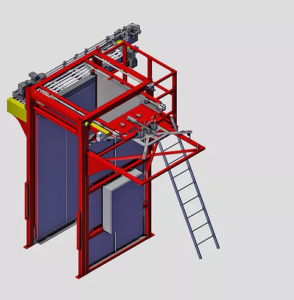
The canning line begins at the DPL-250 depalletizer. Here the cans will be removed from incoming pallets and placed onto the canning line to feed directly into the twist rinse where the cans are inverted, rinsed, and then blown out with compressed air.
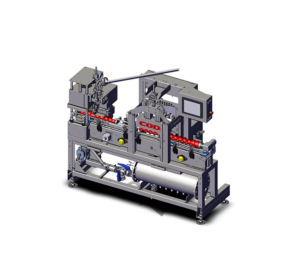 Filler And Seamer
Filler And Seamer
A proper filler must be chosen to perfectly fit the mobile application. To be a competitor in the current market, the filler must produce at least 50 cans per minute and minimize dissolved oxygen within the beverage. Dissolved oxygen will ruin the flavor and desired carbonation levels that make a beer product enjoyable. The filler of choice is the Codi Manufacturing CCL-45. With a fill rate of 55 cans per minute, the CCL-45 provides a competitive output. The counter-pressure filling system offers some of the lowest dissolved oxygen levels in the market. The CCL-45 comes with an integrated HMI display to easily keep track of the canning process and built-in spill pans to prevent any large messes during the filling process. After the cans are filled, this machine also places and seals the lids of the cans. Before the cans can be labeled they must go through a rinse and dry machine to be prepped for the next step of labeling.
PL-501 Labeller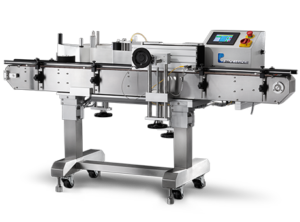
The purpose of a beer can label, beyond providing FDA-required information, is to catch the eye of a prospective customer and be a reflection of the brewery. Besides visual appeal, labels should also be cost-effective, space effective, and remain tough in different conditions. Several options were considered for labeling and were run through a decision matrix. Ultimately it was determined that a standard BOPP (biaxially-orientated polypropylene) wrap-around labeler would be used due to its simplicity, small footprint, rate of output, and moisture resistance. Plastic-backed labels with dairy adhesive will be used to display the brewery’s can art. The machine of choice is the Pack Leader PL-501 Wrap Around Labelling System.
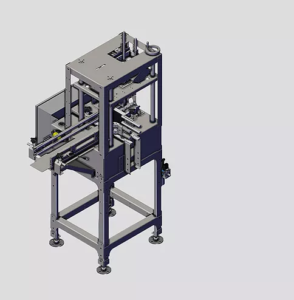
Packager
Packaging is the final stage of the canning process. The packaging process needs to be quick and easy to ensure that it does not back up the entire process. Packaging also has to allow cases to be stacked easily and should be visually appealing to potential customers. Several options were run through a decision matrix. It was determined that Paktech carriers should be used due to their recyclability, high rate of output, and ability to display the can art. The machine of choice is the CODI Manufacturing Paktech Applicator.
Cleaning Procedure
To minimize cross-contamination between various clients’ beverages, a proper clean-in-place procedure will be implemented. This will also help maintain proper safety standards and minimize mold and bacteria growth in the filler lines as well as in the inside of the trailer. A seven-step procedure will be put in place to effectively clean the filling system and remove any excess liquid from the lines to prevent freezing in storage during the winter months.
- Fill internal brewing pot with 10 gallons of hot water
- Mix in 4 scoops (8 oz each) of Super No-Rinse line cleaner
- Recirculate hot cleaning solution between CCL-45 filler and brewery pot
- Replace hot inlet intake line with cold water line from the brewery and flush with cold water into a 30-gallon grey water tank
- Perform visual, conductivity, and cleanliness tests to determine the effectiveness
- Repeat steps 1-5 if not fully cleaned
- Blow out liquid lines with compressed air to prevent freezing during storage
Next Steps
The current design is complete, but it is based on many assumptions that had to be made while the trailer is still a design and is not yet being constructed. All necessary systems and subsystems have been outlined, and products such as the CODI CCL-45 and Twist Rinse have been selected, but the finer details involved in putting them all together and getting the trailer to operate as intended may change. A team picking up this design should take these subsystems and products and further refine them as necessary for the final construction of the trailer.
The creation of a detailed marketing plan is crucial to the success of the product. This report proves the economic viability of the product assuming a certain number of clients, but does not include a method of retaining these clients. The next steps should include a detailed marketing plan to advertise, market, and pitch the service. Economic analysis of the operation of the trailer is preliminary because of its many assumptions. The numbers used and analysis of the market should be updated as the product begins to operate and more concrete data becomes available.
Meet the Team
Colin O'Connell
 I’m Colin, I will be graduating this summer with a BS in Mechanical Engineering. I love working with my hands and my favorite part of engineering is the iterative design process. I am a member of the club mountain biking team and I hope to continue my career with a job working in the bicycle industry. In my free time, I enjoy working on and riding mountain bikes as well as working on project cars.
I’m Colin, I will be graduating this summer with a BS in Mechanical Engineering. I love working with my hands and my favorite part of engineering is the iterative design process. I am a member of the club mountain biking team and I hope to continue my career with a job working in the bicycle industry. In my free time, I enjoy working on and riding mountain bikes as well as working on project cars.
Colter Wagner
 My name is Colter Wagner. I am graduating this May with a BS in Mechanical engineering with a minor in Culture, Communication, and Creativity. I write in my spare time, and I am an amateur bladesmith. Making things is a large passion of mine and it has taught me a lot about appreciating the craftsmanship of books, knives, computers, etc. I have enjoyed working with this group on this project, and I can’t wait to see where they go in the future.
My name is Colter Wagner. I am graduating this May with a BS in Mechanical engineering with a minor in Culture, Communication, and Creativity. I write in my spare time, and I am an amateur bladesmith. Making things is a large passion of mine and it has taught me a lot about appreciating the craftsmanship of books, knives, computers, etc. I have enjoyed working with this group on this project, and I can’t wait to see where they go in the future.
Jake Little
 Hi, my name is Jake LIttle and I will be graduating in May with a BS in Mechanical Engineering as well as a minor in Business & Entrepreneurship. In my spare time, I enjoy working on anything that has wheels so this project was well suited to my passions. It has been a fun and exciting challenge working on this project over the course of the past year and I have enjoyed working with our team throughout our multiple design interactions.
Hi, my name is Jake LIttle and I will be graduating in May with a BS in Mechanical Engineering as well as a minor in Business & Entrepreneurship. In my spare time, I enjoy working on anything that has wheels so this project was well suited to my passions. It has been a fun and exciting challenge working on this project over the course of the past year and I have enjoyed working with our team throughout our multiple design interactions.
Nadia Smith
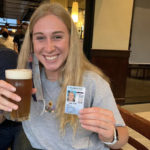 Hi, I’m Nadia and I’m studying Mechanical Engineering. At Mines, I am a member of the Society of Women Engineers and on the Women’s Varsity Swim Team. In my spare time, I like to ski, hike, and spend time with my friends. After graduation, I will be doing a rotational program with Sierra Nevada Corporation and their new subsidiary, Sierra Space.
Hi, I’m Nadia and I’m studying Mechanical Engineering. At Mines, I am a member of the Society of Women Engineers and on the Women’s Varsity Swim Team. In my spare time, I like to ski, hike, and spend time with my friends. After graduation, I will be doing a rotational program with Sierra Nevada Corporation and their new subsidiary, Sierra Space.
Nils Ericsson
 Hi, my name is Nils and I will be graduating with a BS in Mechanical Engineering and a minor in Economics. Over the past four years, I have been a member of the Mines club ice hockey team and have practiced my fly fishing skills. I have enjoyed my time on this project and here at Mines but am excited to see what difference I can make entering the industry.
Hi, my name is Nils and I will be graduating with a BS in Mechanical Engineering and a minor in Economics. Over the past four years, I have been a member of the Mines club ice hockey team and have practiced my fly fishing skills. I have enjoyed my time on this project and here at Mines but am excited to see what difference I can make entering the industry.
Owen Brasseaux
 My name is Owen, I’m about to graduate with a BS in Mechanical Engineering. On top of the knowledge, critical thinking skills, and opportunities for teamwork provided by Mines, I’ve spent the last four years meeting new people and trying new things. Outside of class I am frequently camping, backpacking, or furthering my proficiency in cooking or classical guitar. I look forward to continuing to grow from the experience I have gained at this school.
My name is Owen, I’m about to graduate with a BS in Mechanical Engineering. On top of the knowledge, critical thinking skills, and opportunities for teamwork provided by Mines, I’ve spent the last four years meeting new people and trying new things. Outside of class I am frequently camping, backpacking, or furthering my proficiency in cooking or classical guitar. I look forward to continuing to grow from the experience I have gained at this school.
Sydnee Rumbaugh
 Hi, my name is Sydnee Rumbaugh. I am our team’s resident Electrical Engineer. I am currently interning at High Precision Devices a Form Factor Company in Boulder, Colorado and will continue to work for them after graduation. I love being outdoors and staying active in the beautiful state of Colorado. I was the Treasurer and an active member of the School of Mines Dance Team for three years. This project has taught me the importance of communication and teamwork to achieve goals. It was fun to work with a wide array of individuals with different backgrounds and knowledge to achieve a cohesive and well-rounded project.
Hi, my name is Sydnee Rumbaugh. I am our team’s resident Electrical Engineer. I am currently interning at High Precision Devices a Form Factor Company in Boulder, Colorado and will continue to work for them after graduation. I love being outdoors and staying active in the beautiful state of Colorado. I was the Treasurer and an active member of the School of Mines Dance Team for three years. This project has taught me the importance of communication and teamwork to achieve goals. It was fun to work with a wide array of individuals with different backgrounds and knowledge to achieve a cohesive and well-rounded project.
